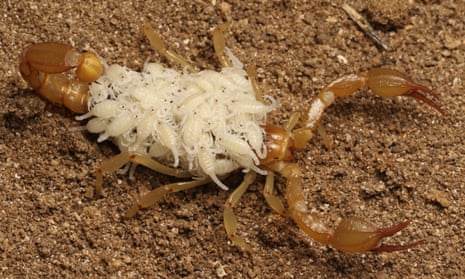A pair of California scorpion species that may have crawled under the radar for tens of thousands of years have finally been exposed – thanks to the efforts of two Bay Area teenagers. And for one at-risk species, the students’ work could prove life-saving.
Prakrit Jain of Los Altos and Harper Forbes of Sunnyvale, 17 and 18 at the time, identified two new species – Paruroctonus soda and Paruroctonus conclusus – after a tip from social media and excursions into the harsh terrain the arachnids inhabit, aided by a black light and Jain’s mother’s car.
It began when Jain and Forbes – who met while working at a nature preserve – spotted the unidentified scorpions on iNaturalist, a social network that allows people to share their observations of the natural world. Users all over the world can upload photos of organisms they’ve spotted and others with expertise in the area can identify them, Forbes explained.
With about 115m observations recorded on the platform, “the real benefit of this for people doing research is that it allows such an enormous amount of data to be present to anybody,” Jain says – data it would “take thousands of people many lifetimes to gather on their own”.

Jain and Forbes have been interested in ecology and wildlife “pretty much our whole lives”, Jain says.
“These kids can find anything,” says Lauren Esposito, an arachnologist at the California Academy of Sciences who collaborated with Jain and Forbes. “You set them out in a landscape and they’re like: ‘Here’s every species of snake, here’s every scorpion, every butterfly,’ and it’s kind of incredible.”
The students check iNaturalist regularly, “seeing if there’s anything that catches our eye”. Unidentified species frequently appear on the platform, but these two examples caught their attention in part because of their small range. They were “geographically isolated”, Forbes says, living around what Esposito describes as salt lakes, or alkali flats – “a former lake from the glacial era, 10,000 years ago, that’s dried out over time”, leaving a brutal desert environment.
That means the scorpions – which look frightening but appear to pose little risk to humans – “have to be able to resist super salty, super hot, arid, dry [conditions], and the only way that they can do that is by adaptation through time. So these things have probably been living in these habitats for tens of thousands of years, through the last major change of the ecosystem,” Esposito says. “They’ve just become isolated there and really can’t exist in the surrounding desert.”
The specificity of their locations made it easier to identify the species without “doing a ton of background work to make a coherent description”, Jain says. But that specificity also brings risks for the scorpions: any threat to their limited habitat, such as solar farms, could be disastrous.
Last year, the students headed to two of California’s dry lakes, Soda Lake and Koehn Lake, where they used a blacklight to try to collect enough of the scorpions to conduct a thorough study. “Looking for scorpions is fairly straightforward if they’re actually out on a given night. Almost all scorpions with the exception of certain families fluoresce under black light, or UV light,” Forbes says. “It could prove quite difficult to collect them in the numbers that we deem appropriate” – typically 10 – “if we didn’t have that tool with us.”
Then began the process of describing the species for a paper with Esposito published last month in the journal ZooKeys – a lengthy effort made pressing by the environmental threat to P conclusus, whose small habitat is not protected (P soda is lucky enough to live within the Carrizo national monument). It’s a tedious process that involves detailed, comparative descriptions of something people haven’t seen before, Esposito says. “That’s why it’s so amazing that these two went through the entire process, because I think for most people at their age, halfway through, they’d be like: ‘I’m done with this.’”
But the pair soldiered on, naming P soda after the lake; P conclusus, they write in their paper, “translates to restricted or confined, in reference to the high degree of habitat specialization and severely limited range” of the scorpion. The paper calls for threatened status for P conclusus, but receiving that designation is another potentially years-long process, Esposito says.

She’s not surprised at Jain and Forbes’ youthful success. She met Jain when he was nine at a community science event. Hunting for scorpions, “he kind of shadowed me as we walked around. And, I mean, honestly, he knew more about the things that we were seeing than I did,” she says. As for Forbes, “he’s taught himself how to illustrate, by hand, anatomical features” – some of which appear in the paper – “which is something that many of my colleagues are still quite awful at after decades”.
Jain, 18, is now a first-year student at the University of California, Berkeley; Forbes, 19, is at the University of Arizona. Both plan to continue studying ecology and evolutionary biology.
Jain says he will maintain a focus on scorpions, noting that the fate of a species like P conclusus has much broader implications.
“The conservation efforts are not meant for just P conclusus itself,” he says. “Its presence in the unique habitat indicates that there’s an entire ecosystem there with many probably relevant factors that we don’t fully understand. So when we’re aiming to preserve this landscape, the idea really is to preserve a completely unique ecosystem and all of the other plants and animals that are living in it for as long as possible.”
